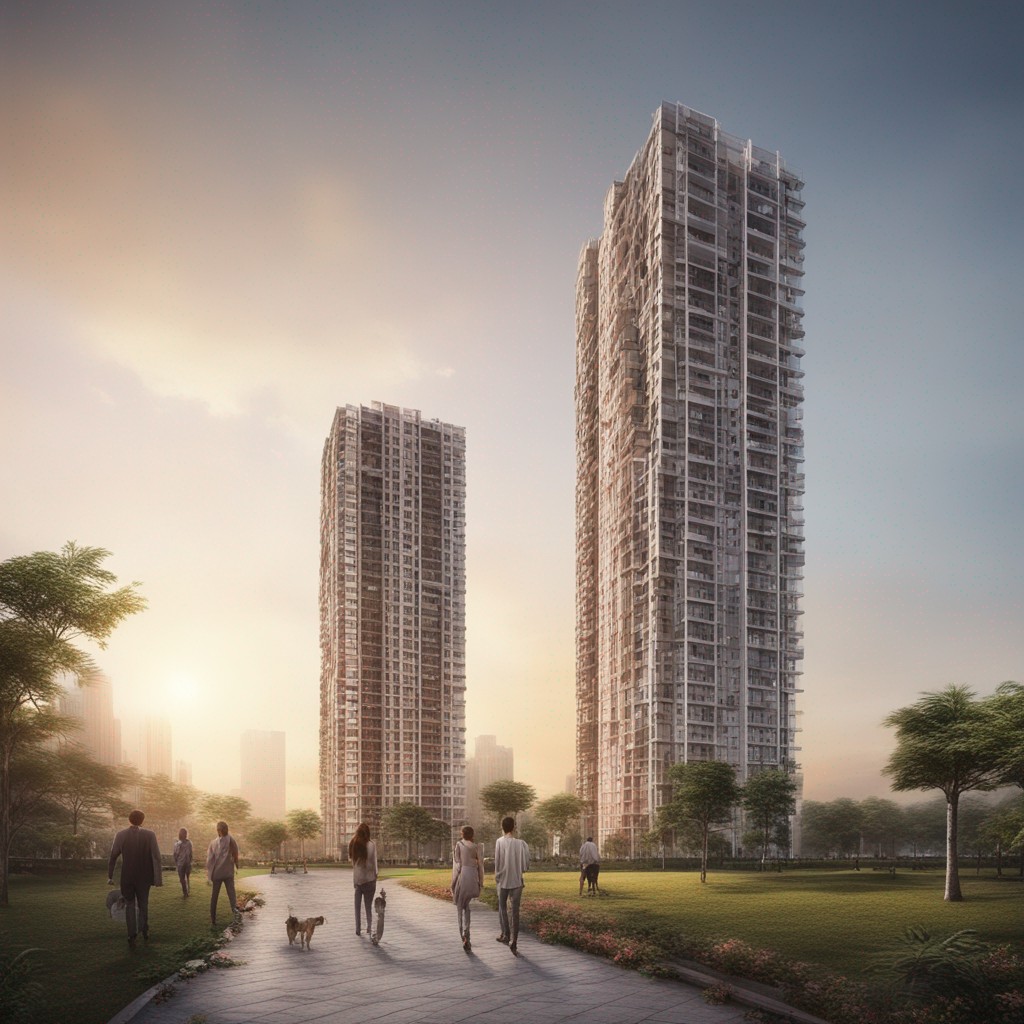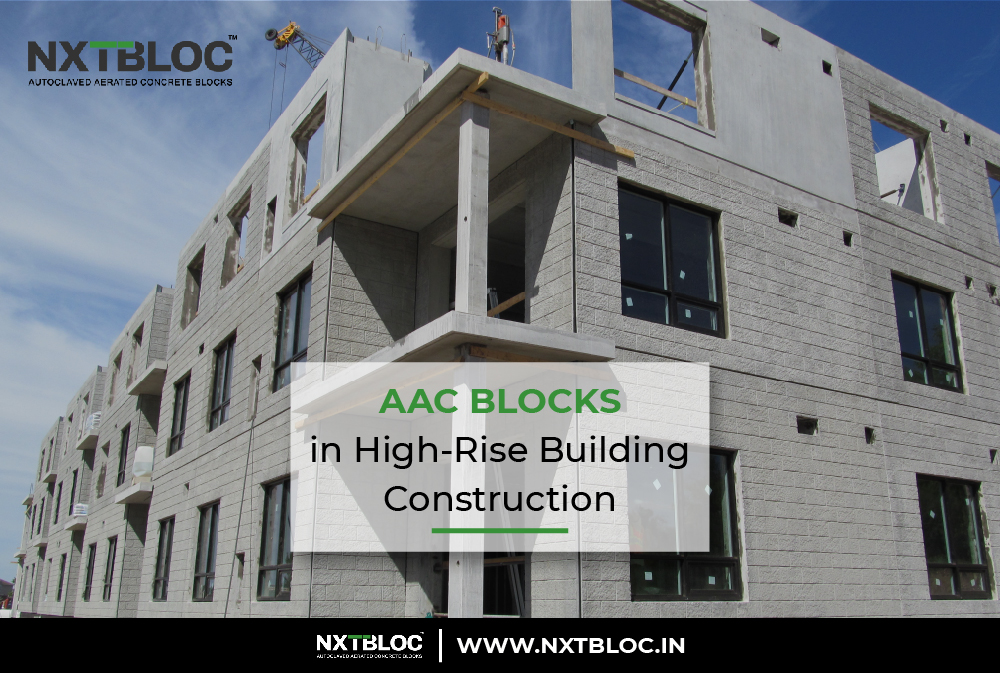Table of Contents
When it comes to erecting soaring high-rise buildings that touch the clouds, architects and engineers are constantly seeking innovative construction materials that offer a delicate balance between strength, safety, and sustainability. One such revolutionary player in the construction industry is the Autoclaved Aerated Concrete (AAC) block. These seemingly unassuming blocks have carved their way into the world of high-rise building construction, redefining the norms and possibilities of what modern buildings can achieve.

Let’s dive into the intriguing realm of AAC blocks and understand their transformative role in constructing towering edifices.
1. Introduction to AAC Blocks
Definition and Composition:
At its core, AAC is a lightweight, precast building material composed of natural raw materials such as sand, lime, cement, gypsum, and a dash of aluminium powder. The unique process of aeration creates a myriad of evenly distributed, microscopic air pockets, resulting in a distinct cellular structure.
Advantages in High-Rise Building Construction:
The inherent advantages of AAC blocks have led to their rapid adoption in high-rise projects. These advantages include exceptional thermal insulation, structural strength, and impressive fire resistance – all critical factors when constructing towering structures that face intense environmental and safety challenges.
2. Thermal Insulation Properties
Cellular Structure and Insulating Ability:
The cellular makeup of AAC blocks contributes to their remarkable thermal insulation capabilities. The multitude of air pockets within the blocks slows down heat transfer, creating a more comfortable indoor environment and significantly reducing the need for excessive heating or cooling in tall buildings.
Energy Efficiency in High-Rise Building Structures:
In the realm of high-rise building construction, energy efficiency is paramount. The superior insulating properties of AAC blocks translate into reduced energy consumption, making them an excellent choice for architects aiming to create sustainable, eco-friendly skyscrapers that leave a lighter carbon footprint.
3. Structural Strength and Load-Bearing Capacity
Reinforced AAC Elements:
The misconception that lightweight translates to weak is swiftly dispelled with AAC blocks. These blocks can be reinforced with steel bars, enhancing their load-bearing capacity while retaining their relatively low weight.
Distributing Loads in High-Rise Buildings:
The lightweight nature of AAC blocks simplifies the distribution of loads across the entire building structure. This not only contributes to the longevity of the building but also allows architects more flexibility in their designs.
4. Lightweight Nature and Reduced Dead Load
Enhancing Foundation Design:
The reduced dead load of AAC blocks can have a cascading effect on the entire building’s design. Foundations can be designed with less stress, potentially leading to cost savings without compromising structural integrity.
Minimizing Structural Stress:
In the context of high-rises, where every ounce of material counts, AAC blocks provide a win-win scenario. Their lightness minimizes structural stress, ultimately extending the building’s lifespan and reducing maintenance demands.
5. Fire Resistance and Safety
Non-combustible Characteristics:
AAC blocks have a unique edge in fire-prone environments – they are non-combustible. Their inorganic composition means that they do not contribute to the spread of fire, enhancing the safety of occupants and emergency responders.
Fire-Related Regulations Compliance:
As urban landscapes evolve, fire safety regulations become more stringent. Buildings constructed using AAC blocks are well-positioned to meet these regulations, offering a reassuring layer of security in high-rise living and working spaces.
6. Acoustic Performance Benefits
Sound Absorption and Reduction:
The interconnected air voids within AAC blocks are not just great insulators; they also excel at absorbing and dampening sound waves. This translates to quieter interiors, a sought-after quality in bustling metropolitan environments.
Noise Control in Urban Environments:
The cacophony of urban living can be overwhelming. AAC blocks play an instrumental role in creating a serene living or working environment by attenuating external noise, fostering well-being, and enhancing the building’s overall appeal.
7. Environmental Sustainability
Low Carbon Footprint Production:
As sustainability takes centre stage in global construction practices, AAC blocks shine as environmentally friendly options. Their production process generates minimal waste, consumes less energy, and reduces carbon emissions compared to traditional construction materials.
Green Building Certifications:
High-rise projects constructed with AAC blocks often qualify for esteemed green building certifications, reflecting their commitment to sustainable practices. This not only aligns with environmental goals but also elevates the building’s value and reputation.
8. Installation Efficiency and Speed
Larger Block Sizes for Faster Construction:
In the race against time that is high-rise construction, AAC blocks emerge as contenders for speed champions. Their larger sizes mean fewer blocks are needed to cover the same area, expediting construction timelines significantly.
Streamlining High-Rise Building Timelines:
Accelerating the construction process is a game-changer, especially in high-rise projects. The efficiency and speed associated with AAC block installation can lead to earlier project completions, reducing costs and time-related risks.
9. Challenges and Mitigations
Specialized Handling Requirements:
AAC blocks demand careful handling due to their lightweight and porous nature. Contractors and workers need to be trained in proper installation techniques to prevent breakage or damage during transportation and installation.
Addressing Permeability Concerns:
The cellular structure of AAC blocks, while beneficial for insulation, can raise concerns about water permeability. Proper waterproofing and appropriate construction techniques can effectively address this challenge and ensure the building’s durability.
In conclusion, the remarkable emergence of AAC blocks as a powerhouse in high-rise building construction has unveiled a new dimension of possibilities. From thermal insulation to structural strength, and from fire resistance to environmental sustainability, these blocks encapsulate the essence of innovation. As the skyline of our cities continues to evolve, AAC blocks by NXTBLOC stand as a beacon of progress, ushering in a new era of safe, efficient, and eco-conscious skyscraper construction.
